Tailoring of items from the remnants of fabric or small cropping-patchworks in the technique of Patchwork (patchwork) is a very creative and quite complex hobby. Collect from small parts such a bulk product, as covered, perhaps only very accusable and diligent needlewomen, but the result will definitely please those who decide on it. Completed using any scheme, such a product will affect the view of a whimsical color game and an intricate geometric pattern, which can be considered by the clock.
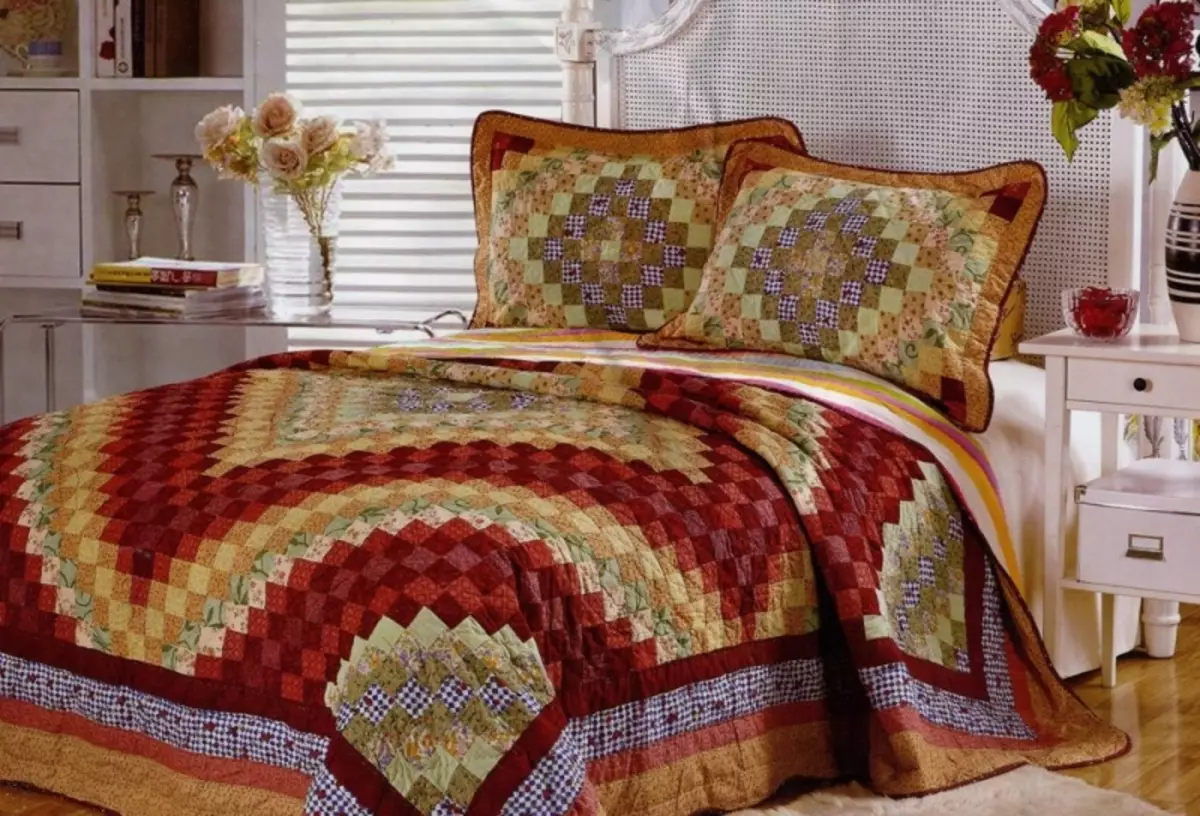
Patchwork is a sewing of things from the flavors of the fabric. This direction was widespread due to the unusualness and attractiveness of things.
To obtain an excellent result when sewing a bedspread or a patchwork, you need to be patient and thoroughly follow the figure of the selected scheme. There are some more important points that will be discussed below.
General Tips for the manufacture of bedspreads
The most important condition is the mandatory disruption of each seam made. In the manufacture of any product of the patchwork, the iron should always be near the craftswoman.How to choose fabric and threads?
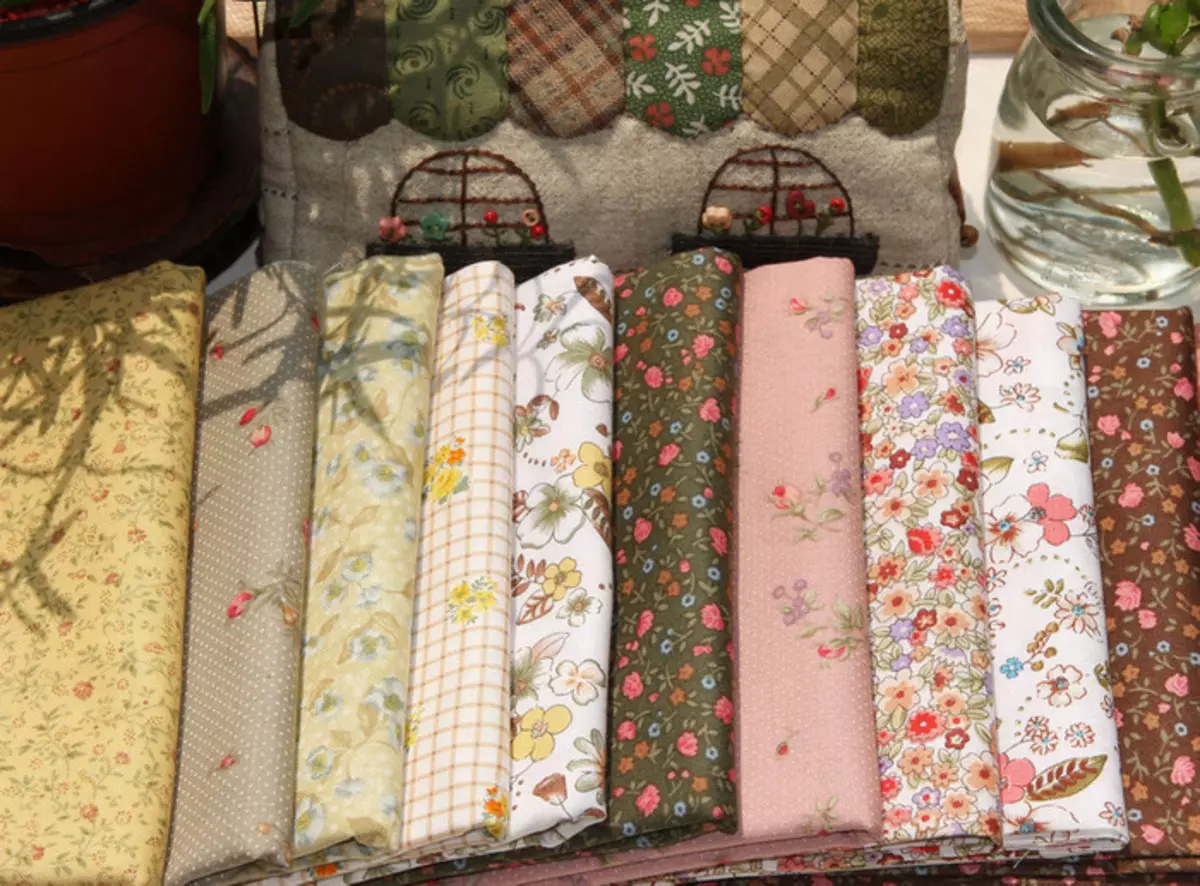
Patchwork is a sewing of things from the flavors of the fabric. This direction was widespread due to the unusualness and attractiveness of things.
To obtain an excellent result when sewing a bedspread or a patchwork, you need to be patient and thoroughly follow the figure of the selected scheme. There are some more important points that will be discussed below.
General Tips for the manufacture of bedspreads
The most important condition is the mandatory disruption of each seam made. In the manufacture of any product of the patchwork, the iron should always be near the craftswoman.How to choose fabric and threads?
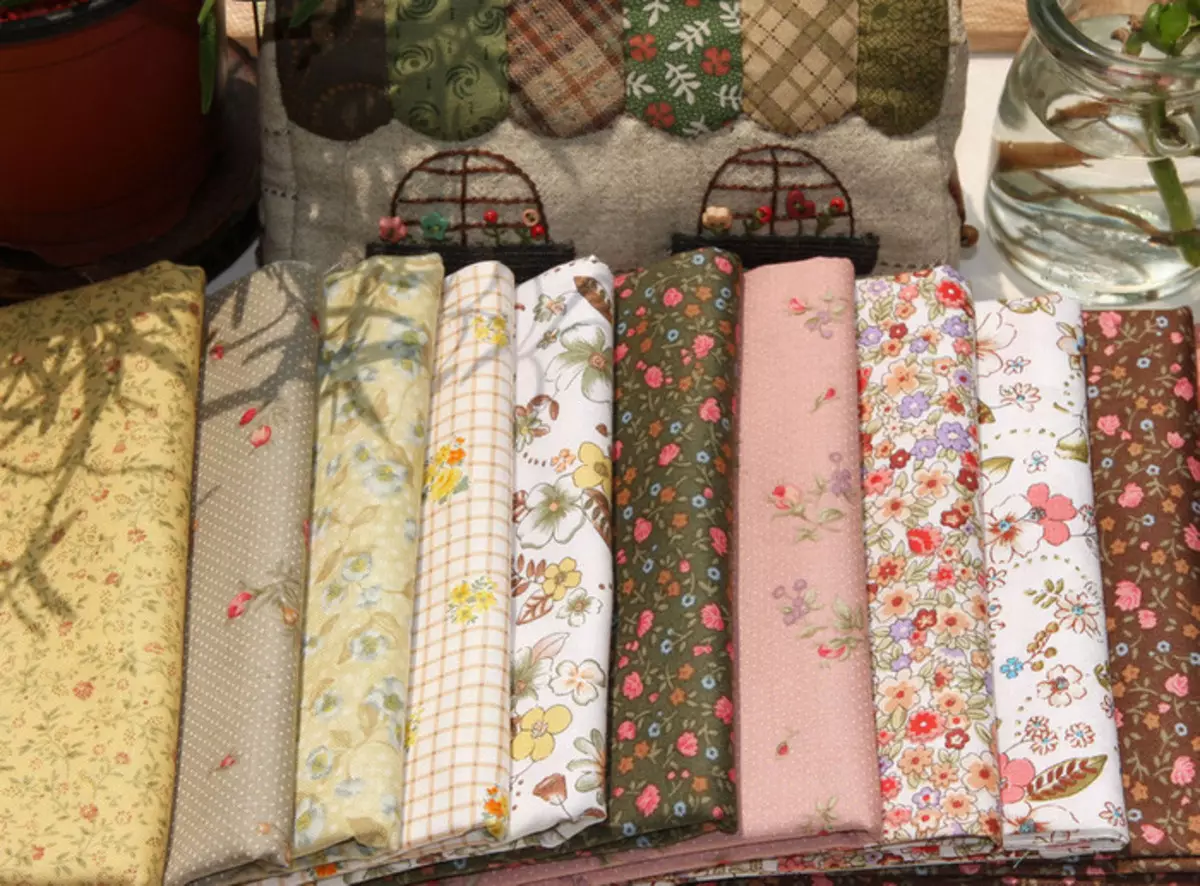
Patchwork fabric can be used any. It is only desirable that it was the same texture to begin.
Those who are just starting to master the technique of Patchwork, it is recommended to work with the tissues of the same texture. For sewing, you can use almost any material, but natural cotton or linen fabrics are best suitable for bedspreads or blankets, you can use satin or silk patchwork. Very thin fabrics and silk before opening it is desirable to "plant" on the adhesive basis (Flizelin or others).
If old things are used to sewing the blanket, you will need to prepare material for work:
- cutting and cut the seams;
- wash;
- rejuvenate;
- Select only fabrics with stable color;
- Do not take too worn out tissue areas.
Article on the topic: Replacing the loops of balcony plastic doors
The color gamut is selected, or using contrasting colors, or combining the shades of one color of different saturation. A variant of the harmonious combination of related colors is also possible. The triangle inside it shows the perfect combination of 3-colors. One of the vertices indicates the main, 2 others - on the combined colors. To determine the contrast, spend direct through the center from the main color. The resulting shade and will be contrasting for it. Related can be called colors that are near the main (left and right from it).
For lining (inside) the patchwork covers will need a fabric of good quality, durable, preferably new, from natural X / B fibers.
For laying in modern products, a synthetic trunk density is 100 and 200, for bedspreads and blankets, respectively.
Treads for sewing need to use high quality and strength. For bedspreads from cotton or flaxes, it is better to use threads No. 45-50. Color them can be selected in tone with tissues or be contrasting.
Why do you need a template?
Template diagram for patchwork.
In order to reveal the set of identical small parts, it is convenient to use independently made templates. The simplest of them are geometric shapes (square, rhombus, triangle).
More complex schemes usually contain drawings of all parts, of which the product is sewn through this drawing.
The template is drawn on the cardboard or other durable material in a natural value, add a perimeter 1 cm of an allowance for the seams. The inner figure is cut out by a stationery or knife, then cut out over an external contour. The resulting frame with string is put on the fabric and both contour are reduced.
The process of manufacturing a patchwork blanket
Any scheme is designed for a certain amount of product and a specific number of fragments. These numbers can be changed if necessary. To do this, you can reduce or increase both the sizes of each fragment and their number.
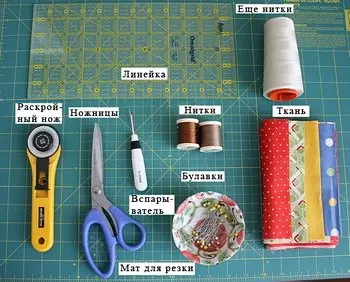
Tools for patchwork.
When selecting colors, you can use the directions of the selected scheme or proceed from the color gamut that is available. With an independent selection of flowers, it is important to remember that half of the flaps should be dark shades, and half - light. For work, the following tools and materials will be required:
- sewing machine;
- iron;
- English and ordinary pins;
- Threads No. 45-50, needle;
- Loskutka fabric.
Article on the topic: Covers for chairs in the kitchen - Tips on cutting and selection of materials for sewing
The easiest option is a blanket of square fragments
By defining the desired dimensions of the product, you can calculate how many squares and what size will be needed for its manufacture. At the same time, you need to take into account the allowances for the seams and edging around the perimeter of the blanket.
After the calculations you need to make a template, the instruction for its manufacture is above. Put the finished frame on the wrong side of the flap and cover the external and inner contours. Carry out the external lines. Internal denotes the location of the machine line.
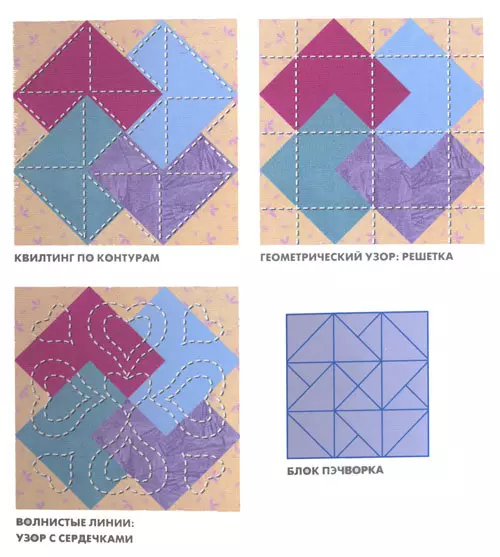
Patchwork pattern circuit.
- Crawled squares are folded by the front sides to each other, they are cleaned with pins and rapidly. Deploy, stroking the seam. So connect several squares in the strip, the length of which is equal to the width or length of the product. After that, other bands are sewn, not forgetting alternating the squares of the dark and light tone. Strips connect with each other, stroking all the seams. The resulting canvas on the edge is trimmed with a border of the tissue of a contrast or combined with the colors of squares of the shade.
- Then lining and a padding layer from the synthetone, spread on a large smooth surface to face down, syntheps and patchwork cloth face up. From the center to the edges thoroughly smoothed and align the top layer, gradually the rocking layers of English pins in increasingly 10 cm. Instead of rocking, you can start the blanket with straight lines along, across and diagonally. In completion, soap is painted in the middle of the fragment any closed line, repeat on neighboring squares. If you need to get a symmetrical or identical pattern, it is better to make an appropriate pattern.
- Starting from opposite edges, fold the blanket to the center in 2 rolls. The next stage is the stitch of the patchwork blanket. Perform it like this:
- slightly unfold one of the rolls;
- Starting from the center of the product, they stick to the typewriter each drawn line, all the time sprawling the fabric with hands;
- When you finish the deployed part, go to the next.
- In order not to rotate the stitch blanket, you need to turn off the fabric feed mechanism ("Embroidery" mode), set the stitch amount "0", weaken the top thread and install the footrest (duct). When sewing the product moves manually in any direction.
- When the blanket is rude, remove the backbone or pins and switch to the edge processing. To do this, it will be necessary to sew a ribbon with a width of 6-8 cm, a total length of the perimeter of the finished product, plus a few centimeters on the joint. Seams connecting individual parts of the tape, you need to operate.
- Ribbon folded along in half the face side (edges of the seams inside) and fought the fold. Schedule or leaf open sections of ribbons and edges of the blanket around the perimeter, the ends to connect the flashes, bending the inside that it turns out to be top. Run a machine line around the perimeter of the product, curb the tape on the other side of the blanket. Along the starting fold, make another line around the perimeter at a distance of 1-2 mm from the edge of the tape.
Article on the topic: how to bring bed bugs at home by folk remedies
More complex sewing schemes

Patchwork diagram "Well".
To make a plaid from the "Well" fragments, you will need squares by the number of blocks and strips for multiple layers of framing: the central square and 3 layers of the framing of different color. Shot such a block so:
- central square and strip to learn to each other;
- stitch
- Bend, run in the seam;
- repeat from the opposite side of the square;
- Similarly, sew 2 strips from other sides;
- Repeat for each framing layer.
The finished blocks are squares from the pillars, so it is necessary to connect them as indicated in the example of the sewing of the patchwork of squares.
The complicated version of this scheme can be done by cutting each block through the center by 4 squares. Connect the squares among themselves, alternating parts of different blocks. Further go as with conventional squares.
For the plaid of 6 coal elements, it will be necessary to make an appropriate template. Place and carve out the details of the flaps. On the central excavation of the template, cut hexagons from paper.
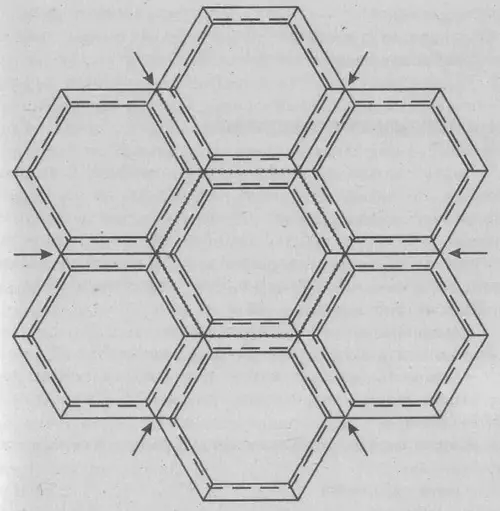
Scheme of the junction of hexagons.
Attach with several stitches paper patterns to the involve of fabric and adjust the tapping edges of the tissue on paper, estimating, so that they are not inflicted.
The obtained parts to sew each other suture "across the edge" by selecting elements in color. The resulting blocks in the form of a flower are combined between themselves in the canvas. Remove threads mark and remove paper templates from blocks.
To process the edge on the frame ribbon, impose the edge of the canvas face up, connect with the front side of the secret seam along the contour. Then make a lining and handle the edge as indicated for a blanket from squares.
Selecting the fabrics and using the schemes of the likelled covered from the pillars, you can create beautiful and exclusive things from the cast material: waste from sewing or served your belongings.
Patchwork bedspread knew how to make every woman during the times of our grandmothers, gently assembled trimming with loose shirts and dresses. Some of these masterpieces served several generations in the families of the needlewoman.
